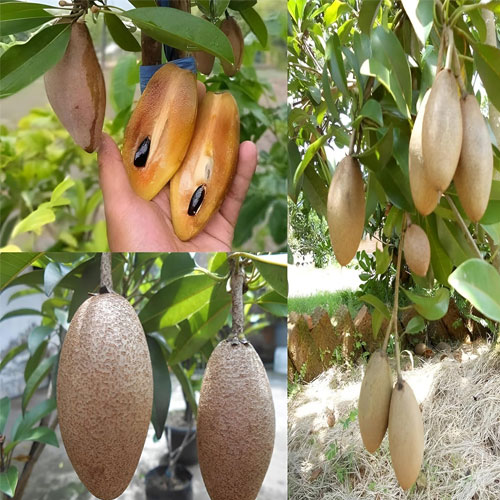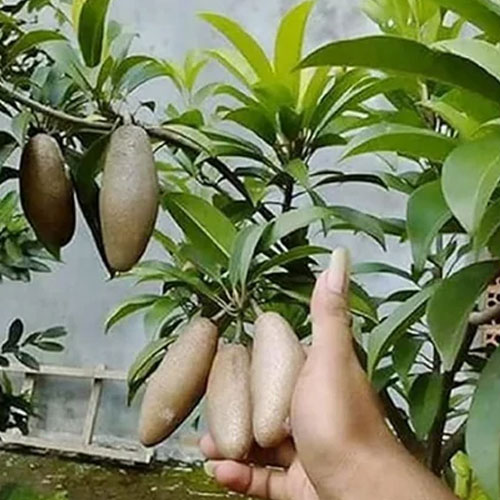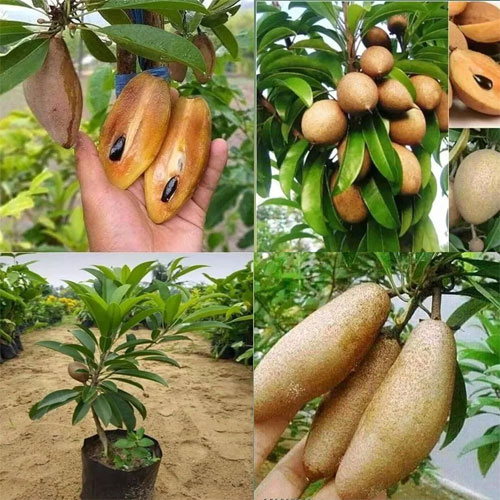The Thai Banana Long Sapota (Chikoo) Grafted Live Plant is a rare and exotic variety from Thailand, known for its long, banana-shaped fruits with a rich caramel-like sweetness. This unique sapota variety combines beauty, productivity, and taste — producing high-quality fruits that are both aromatic and flavorful. The Golden Hills Farm grafted plant ensures early fruiting, high yield, and disease resistance, making it ideal for Indian home gardens, farms, and terrace setups. With its tropical charm and all-season growth potential, this Thai variety delivers delicious, elongated sapota fruits that are soft, juicy, and filled with natural sweetness.
Type of Plant: Grafted Fruit Plant – Thai Banana Long Sapota (Chikoo) Variety
Scientific Name: Manilkara zapota
Germination Time: 10 – 15 days (for new growth after planting)
Sunlight Requirements: 6 – 8 hours of bright sunlight daily
Where to Grow: Terrace gardens, home gardens, or open fields
Growing Season: June – September (monsoon) or February – April (spring)
Soil Requirements: Loamy, fertile, and well-drained soil enriched with compost
Plant Height: 1.5 – 2 feet (at dispatch)
Fertilizer Needs: Organic compost or cow dung every 30–45 days
Life Span: Long-lived tropical fruit tree (bears for 20+ years)
Ideal Growing Temperature: 22 °C – 35 °C
Blooming / Harvesting Time: Flowers in spring; fruits 6–8 months after flowering
Maintenance Required: Low; occasional pruning and feeding
Watering Frequency: Twice per week for young plants; weekly when mature
Ideal Grow Bag Size: 18 × 18 inches or larger



The Thai Banana Long Sapota Plant adapts perfectly to India’s tropical and subtropical climates. It can be planted year-round but performs best when planted during the monsoon (June–September) or spring (February–April). The grafted variety begins fruiting within 1–2 years, producing long, cylindrical fruits with a soft texture and naturally sweet flavor similar to brown sugar and caramel.
Choose a large 18×18 inch grow bag or clay pot with drainage holes. Fill it with equal parts of garden soil, compost, and sand. Plant the grafted sapota upright, cover the roots, and water thoroughly. Keep in full sunlight for 6–8 hours daily. Apply organic fertilizer every month and ensure the soil stays slightly moist but not waterlogged.
Preparation: Prepare a soil mix of garden soil, sand, and compost for good drainage.
Planting: Dig a 1×1×1 ft pit, place the plant upright, and fill gently with soil.
Watering: Water deeply after planting and keep moist for the first 2 weeks.
Germination: Grafted plants establish fast and start fruiting within 1–2 years.
Transplanting: Move to open soil or larger containers as roots develop.
Sunlight: Needs full sunlight (6–8 hours daily) for best fruiting.
Soil: Use fertile, loamy soil enriched with organic matter.
Fertilization: Apply compost or neem cake every 30–45 days.
Pruning: Lightly prune after harvest to encourage new growth.
Support & Spacing: Keep 5–6 ft spacing between plants in open areas.
Pest Control: Use neem oil spray to prevent aphids and mealybugs.
Disease Prevention: Avoid waterlogging to prevent fungal issues.
Mulching: Apply dry leaves or straw to retain soil moisture.
Harvesting: Fruits are ready when they turn light brown and soft to touch.
1. Apply Nutrient-Rich Fertilizers
When your plants begin flowering, use nutrient-rich fertilizers like Organic Bone Meal Powder or Vermicompost. This helps in boosting the bloom and enhances overall yield.
2. Use Organic Fertilizers
Feed your plants with organic fertilizers such as Cow Dung Manure or Neem Cake. Organic options promote healthy soil life.
3. Regular Feeding
Apply fertilizers every 20-25 days to ensure plants receive a steady supply of nutrients. Choose from various options like Cocopeat Compost for moisture retention.
The Thai Banana Long Sapota Grafted Live Plant is a rare, exotic, and high-yielding variety producing banana-shaped, elongated fruits that are naturally sweet and aromatic. This plant is early-fruiting, tropical, and disease-resistant, suitable for both home growers and commercial cultivators. The fruits have a unique caramel flavor and creamy texture, making them perfect for desserts, milkshakes, and fresh eating. Its compact growth habit and lush green foliage also add a decorative touch to gardens.
Produces long, sweet, banana-shaped sapotas.
Early fruiting grafted plant with high yield.
Excellent for fresh eating, milkshakes, and desserts.
Disease-resistant and easy to grow in Indian climates.
Ornamental tropical tree with attractive foliage.
Avoid overwatering; keep soil well-drained.
Protect young plants from strong winds.
Keep in full sunlight for strong growth and fruiting.
Use only organic fertilizers for healthy development.
Do not transplant frequently once established.
Problem: Leaves yellowing or curling.
Solution: Improve drainage and apply organic compost.
Problem: Fruit drop before ripening.
Solution: Ensure consistent watering and apply neem oil spray.
Problem: Slow growth.
Solution: Increase sunlight exposure and add cow dung manure monthly.
Long Chikoo, Thai Banana Sapota, Long Sapodilla, Chikku Maram, Sapeta, Naseberry, Sapota Pazham, Manilkara Tree, Banana Chikoo Variety.
Q1: When will the Thai Banana Sapota start fruiting?
👉 Usually within 1–2 years after planting (grafted variety).
Q2: Is the fruit long and sweet?
👉 Yes, it produces long, banana-shaped fruits that are very sweet and aromatic.
Q3: Can it grow in pots?
👉 Yes, it grows well in large terrace pots with good sunlight.
Q4: How often should I fertilize the plant?
👉 Once every 30–45 days with organic compost or manure.
Sign in now to receive a 5% instant discount on your first order when using code WELCOME. Begin your organic journey today!
By logging in, you're agreeing to our Terms of Service and Privacy Policy.
Anjali Reddy
Plant rare aur pest-free tha. Delivery time par aur condition perfect. 🌱
Suresh Bhat
Golden Hills Farm ka product hamesha top quality hota hai. Rare long sapota bhi perfect aayi. 🌿
Kavya Iyer
Healthy aur pest-free plant mila. Fruits ka wait kar rahi hu. Bahut accha plant. 🍈
Rajesh Varma
Plant ka health perfect tha. Grafted section visible aur no pest issue. 🌿
Divya George
Compact aur lush green plant. Delivery safe thi aur packaging neat. 👍
Nikhil Verma
Plant healthy tha par thoda dry lag raha tha. Water dene ke baad revive ho gaya. 🌿
Meera Krishnan
Rare long sapota variety finally mil gayi. Grafted point clear aur plant strong tha. 🌿
Harish Rao
Healthy aur well-rooted plant mila. Soil moist thi aur koi damage nahi hua. 🌱
Sneha Pillai
Plant thoda chhota tha par leaves fresh thi. Ab new growth aane lagi hai. 🌿
Rohit Menon
Long chikoo variety rare hai. Plant grafted aur compact tha. Healthy condition me mila. 👍